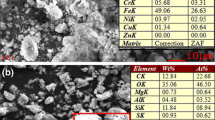Abstract
The main objective of this study is to characterize and find a potential use of textile effluent treatment plant (ETP) sludge produced in Bangladesh. Textile ETP sludge collected from the local textile industries have been characterized in the laboratory. The physicochemical and engineering properties of the sludge have been studied. Collected ETP sludge has been processed to get cement-like fine powder that has been used for partial replacement of Portland cement/sand in the composition of the mortar and concrete specimens. Different mechanical (compressive and flexural strength), physical (water absorption) and morphological (porosity) properties of the test specimens have been evaluated. The test result shows that the addition of sludge in the mortar and concrete composition as a substitution of Portland cement or sand decreases the compressive strength and flexural strength, and increases the water absorption and porosity of the mortar and concrete specimens. Leaching study, conducted for the sludge-based mortar and concrete specimens following tank leaching test procedure, reveals that the concentration of leached metals is quite low than the limits specified by the Department of Environment in Bangladesh. These results amply demonstrate that textile ETP sludge can be utilized for making non-structural building components where lower strength is justified.
Similar content being viewed by others
References
European Commission (EC): Guide book for European investors in Bangladesh, sector profiles, Asia Investment Facility, The textile sector in Bangladesh, Aisa-Invest Secretariat, 17 rue Archimède, B-1000, Brussels (2001)
Islam, M.M.; Mahmud, K.; Faruk, O.; Billah, M.S.: Textile dyeing industries in Bangladesh for sustainable development. Int. J. Environ. Sci. Dev. 2(6), 428–436 (2011)
Palanivelu, K.; Rajkumar, R.: Characterization and leachability studies on textile effluent treatment plant sludge. Environ. Pollut. Control. 5(1), 38–40 (2001)
DoE and Waste Concern: Waste database of Bangladesh. Department of Environment, Bangladesh (2008)
Balasubramanian, J.; Sabumon, P.C.; Lazar, J.U.; Ilangovan, R.: Reuse of textile effluent treatment plant sludge in building materials. Waste Manag. 26, 22–28 (2006)
Sengupta, P.; Saikia, N.; Borthakur, P.C.: Bricks from petroleum treatment plant sludge: properties and environmental characteristics. J. Environ. Eng. 128(11), 1090–1094 (2002)
Garg, M.; Singh, L.P.; Maiti, S.; Pundir, A.: Characterization of automobile effluent treatment plant sludge: its utilization in construction materials. Constr. Build. Mater. 73, 603–609 (2014)
ASTM standard: Standard test method for mechanical mixing of hydraulic cement pastes and mortars, Annual Book of ASTM Standards ASTM C109 (1984)
ASTM standard: Standard test method for compressive strength of cement mortar, Annual Book of ASTM Standards, ASTM C305 (1984)
Mehta, P.K.; Monteiro, P.J.M.: Concrete: Microstructure, Properties and Materials. McGraw-Hill, New York (2006)
JSCE standard: Standard test method for leaching of trace elements from hardened concrete, Concrete Engineering Series 69, Japan Society of Civil Engineers Tokyo, Japan, pp. 107–120 (2006)
Sugiyama, T., Takahashi, S., Honda, M., Sakai, E.: Current state of the JSCE standard on test method for leaching of trace elements from hardened concrete. In: Kraus, R.N., Naik, T.R., Claisse, P., Pouya, S. (eds.) Proceedings in International Conference of Sustainable construction materials and technologies, pp. 197–203. Coventry Pub., UW Milwaukee CBU (2007)
Department of Environment (DoE): The environment conservation rules 1997 (1997)
Acknowledgments
The authors are grateful to the Envoy Group Bangladesh Ltd. and Housing and Building Research Institute, Dhaka, Bangladesh, for their financial and laboratory support. Also, the authors like to acknowledge analytical laboratory support of Bangladesh Council of Scientific and Industrial Research in analyzing the sludge sample.
Author information
Authors and Affiliations
Corresponding author
Rights and permissions
About this article
Cite this article
Rahman, M.M., Khan, M.M.R., Uddin, M.T. et al. Textile Effluent Treatment Plant Sludge: Characterization and Utilization in Building Materials. Arab J Sci Eng 42, 1435–1442 (2017). https://doi.org/10.1007/s13369-016-2298-9
Received:
Accepted:
Published:
Issue Date:
DOI: https://doi.org/10.1007/s13369-016-2298-9




